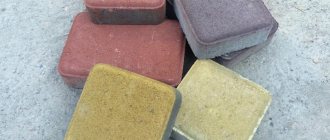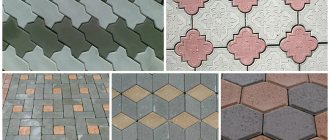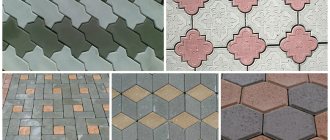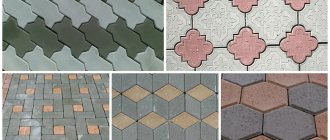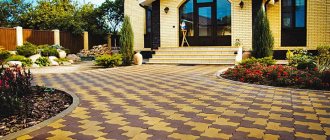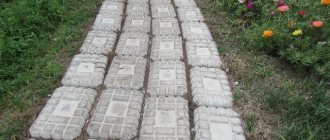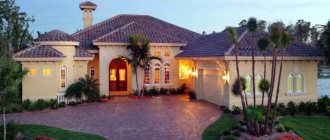Organization of delivery throughout Russia, Belarus and Kazakhstan.We organize delivery throughout Russia through transport companies at your expense. Shipment from the warehouse is free. Features of ordering forms for concrete products.Orders for forms for paving slabs, paving stones, facade tiles, concrete siding and facing stones are accepted in quantities of at least 3 sq.m. by position . All other items can be ordered as a set, or one piece at a time if a set is not provided. | ||
Forms of concrete products
Molds for the manufacture and production of small architectural forms (SAF) - vases, benches and other artistic and decorative products for external improvement.Price from 500 rubles per piece or set.
Catalog of forms for small architectural forms
A very important condition for the production of good paving slabs are high-quality shapes.
Currently, there are two main types of manufacturing paving slabs - vibration pressing and vibration casting.
Vibrocompression is usually used when organizing flow production in order to obtain large volumes of product at once. This process is quite fast and does not require active human intervention, but it has one significant drawback - a small number of types of products produced.
But the vibration casting process is focused primarily on the production of a variety of paving slabs, and therefore it uses a variety of shapes - from simple rectangular ones to intricate curly ones with many patterns and cutouts, as well as special ones (for making prefabricated patterns).
Manufacturing instructions with photos
Let's look at how to make different homemade molds for paving slabs with your own hands. Much depends on the material of manufacture.
Watch a useful video on how to create a product diagram:
Wooden
The most accessible way . To work, you will need wooden blocks that are connected to each other in such a way as to form a closed figure, the inside of which is the outline of the future tile. It must be remembered that the outlines of the tiles must correspond to each other so that they can be tightly arranged together.
It is not recommended to use any complex outlines , simple geometric shapes - square, rectangle, hexagon. Attention must be paid to the accuracy of the internal dimensions; for our task, only they are important.
The bars are connected to each other using screws. If the figures are square or rectangular, be sure to measure the lengths of the internal diagonals , they must be the same. On hexagons, you should monitor the correctness of the angles, for which you can use a protractor, or make an accurate template.
Assembling the matrices is quite simple . Blanks cut to length are assembled to specified sizes and shapes using screws. The inner surface is thoroughly cleaned and sanded with sandpaper. Then you need to cover the mold with several layers of drying oil, varnish, etc.
Some sources claim that you can do without this, simply moisten the mold with soapy water before use.
However, this statement is controversial; the finished form may be needed later for partial repairs, so protection from water is necessary.
Plastic or polyurethane
Manufacturing takes place in two stages . First you need to make a wooden mold for pouring the plastic. In this case, it must be taken into account that the internal dimension should be 2 cm larger than required; this is an allowance for the wall thickness.
Then you need to assemble another frame that exactly follows the outline of the future plastic form.
It is placed inside the first one so that the gap is uniform. Molten plastic is poured into it . If polyurethane is used, the two-component mixture of which has a harmful effect on the body, it is necessary to ensure good ventilation of the room and use personal protective equipment.
To make products with geometric patterns or more complex configurations, you will need an exact model of the future tile, which is placed in a box and filled with polyurethane.
After hardening, the product is removed from the matrix , uneven areas are treated with sandpaper. This produces a form that can withstand repeated use, but the process itself requires experience and skill. If there are none, it is better to abandon this method.
Metal
The advantages are a flat, smooth surface, low reaction to exposure to water, and strength.
Disadvantages - it is quite difficult to make such a form ; it makes sense to do this only when counting on large volumes and a long service life.
The product is not flexible , so it is better to make it collapsible to avoid breakage of the finished tiles when knocked out.
There can be many manufacturing options , it all depends on the capabilities of the master and his imagination. Most often, square, rectangular or hexagonal frames are simply welded into which concrete is poured.
If you combine such shapes with a relief bottom that imitates the texture of stone, wood or a geometric pattern, then the finished tile looks very solid.
Silicone
They have the same advantages as polyurethane ones - flexibility, accuracy of repetition of the original ornament , and the possibility of repeated use. At the same time, silicone will cost much more than other materials. In addition, such forms are more flexible and do not hold as firmly, which can cause slight distortions in the castings.
The manufacturing process is similar to working with polyurethane - you will need a master model. It is placed in a box, silicone is mixed with a catalyst and hardener and poured into the box in such a way as to cover the model with a layer of at least 1 cm.
After crystallization of the composition, the silicone mold is removed from the model. The operation takes about a day .
In this video you will learn how to make molds for the production of paving slabs yourself:
Plaster
Making plaster molds is a simple and affordable method ; the only condition is the availability of a sample or master model.
The manufacturing principle is simple - a wooden box is made, 10 cm larger than the model, plaster is poured into it and a cast of the model is extruded. As an option, the model is filled with a layer of plaster and carefully removed. The surface of the model must be coated with varnish or wax mastic so that the plaster does not stick to it.
It is recommended not to use gypsum in its pure form , but to create a molding mixture that is much stronger and does not crack or shrink when hardened. The finished cast must be soaked several times with drying oil or varnish to prevent it from getting wet during work.
The advantages of this method are the low cost of the material and ease of manufacture. You can make several molds at once, which will allow you to cast several tiles at a time, reducing production time.
On our website you will also find out what patterns for laying paving slabs can be! We offer you to look at the 5 most popular drawing options.
And in this material you will find a training video on the technology of laying paving stones! Find out all about the features of working with this material.
Bavaria
This form is becoming increasingly popular with our customers every year and will soon become a new bestseller. It entered the market in 2022, and managed to fall in love with many owners of country houses. The tile consists of rectangular parts of 4 sizes of small and medium format: 280x210, 210x140, 140x140 and 140x70 mm. Thickness – 60 mm, edges without chamfer. The front layer can be different:
1595 rub. per sq. m.
Bavaria Steingot 60 mm Travertine
Go to catalog
Paving with paving slabs Steingot Bavaria color Travertine. Mosaic layout
1440 rub. per sq. m.
Bavaria 342 MZ 60 mm Arctic
Go to catalog
Paving with paving slabs 342 Mechanical plant Bavaria color Arctic. Mosaic layout
The shape is suitable for laying straight paths, square and rectangular areas.
Allows you to implement the most daring design solutions and goes well with modern houses in the high-tech, modern, and constructivist styles. Laying schemes:
2185 tile options in our showroom from 12 factories
More details
Which material is better
In terms of surface quality, flexibility and durability, the leaders are polyurethane, silicone, and plastic . They do not react to moisture, are easy to clean, and can withstand a large number of operating cycles without any problems. At the same time, they are much more difficult to manufacture than wooden products, less durable than metal ones, and much more expensive than plaster ones.
The training of the master should be taken into account . For one it is preferable to work with wood, for another - with metal, etc. The final result is largely determined by the level of professionalism of the manufacturer.
Most often, it is not so much the material that is decisive, but the skills of the worker.
Any product bears the imprint of the master’s personality, so it is difficult to clearly name the best material.
Classico
Medium format tile with 3 parts with a rounded edge, imitating stone paving stones. The size of the stones varies between 172x115, 115x115 and 57x115 mm, thickness - 60 mm. It is used for laying paths, recreation areas, parking lots and blind areas of houses. One of the best options for landscape-style plots with houses made of timber and logs, in harmony with frame buildings, country-style buildings, and chalets. Often used in small cottages. Examples of using:
1003 rub. per sq. m.
Classico Braer 60 mm Brown
Go to catalog
1003 rub. per sq. m.
Classico Braer 60 mm Sand
Go to catalog
1003 rub. per sq. m.
Classico Braer 60 mm Wine
Go to catalog
Paving with Braer Classico paving slabs in wine, sand and brown colors. Row layout
969 rub. per sq. m.
Classic Steingot 60 mm Brown
Go to catalog
Paving with Steingot Classic paving slabs in beige and brown colors. Row layout. View project
Paving creates wide joints where grass can grow over time. Suitable for those who want to create more natural alleys, but you need to take into account that it will be uncomfortable to walk on the surface in heels and roller skates.
2088 rub. per sq. m.
Classico Choice 40 mm Stonemix White
Go to catalog
2088 rub. per sq. m.
Classico Choice 40 mm Stonemix Black
Go to catalog
2088 rub. per sq. m.
Classico Choice 40 mm Stonemix Black and white
Go to catalog
Paving with paving slabs Choice of Classic Stonemix colors White, Black and Black and White.
Row layout Layout schemes:
How to make silicone and wood molds?
Silicone molds for paving slabs also do not require special skills or tools for production. Almost every craftsman can make them with his own hands. The material used is silicone, consisting of several components. To increase wear resistance, a catalyst and hardener are added to the base. They are added to the mixture in certain proportions. The base into which the silicone is poured is cleaned of contaminants and degreased. It is made from any solid material. Sculpting clay can be used to create the desired configuration or design. The base is lubricated with a thin layer of vegetable oil, and then liquid silicone is poured into it in a thin stream. The material hardens in about a day.
The process of creating a frame for a plastic base will largely tell you how to make wooden forms for paving slabs. The difference is that the boards are fastened together with iron corners. They are laid on a flat and smooth surface so that later the finished product can be more easily separated from the work surface. When the concrete dries, the forms are partially dismantled. To do this, screws are first screwed into them, which are easily removed after the concrete solution has hardened. There is one caveat to working with such basics. When concrete is poured into them, a reinforcing mesh is laid in the middle of the thickness of the product.
In the end, let us give some advice to future masters. When making molds, it is necessary to provide corner and end elements. Then, when laying, the tiles will not need to be cut. To increase the efficiency of the production process, it is recommended to make several bases identical in size and design.
Large format slabs 600×300
Large rectangles without chamfer allow you to get smooth paving on large areas, wide paths, and driveways. It is convenient to move on such a surface on foot and on wheels. The shape is combined with modern high-tech buildings and brick houses. It is used for landscaping private areas, but is more suitable for courtyards of residential complexes, city boulevards, squares and squares. Laying schemes:
Row laying is predominantly used, but it is worth considering that large-format slabs are heavy and difficult to install manually.
Old city
Medium-format tiles made of 3 rectangular elements with a flat front surface or a relief “antique” surface. Feature - the length of the largest part is equal to the total length of the other two. The shape goes well with houses made of timber, brick, and plastered facades. It is the most popular among our customers and is one of the top sellers. Example:
Old Town "Landhouse" from BRAER. Element sizes are 240x160, 160x160 and 80x160 mm. Height – 60 and 80 mm. The plant has a new product that will make paving more economical - the Old Town "Venusberger" with a height of 40 mm. A coating made from it will also be strong and beautiful, but will be cheaper due to the reduced dimensions of the tiles.
1556 rub. per sq. m.
Old Town Landhaus Braer 60mm Fog
Go to catalog
1003 rub. per sq. m.
Classico circular Braer 60 mm White
Go to catalog
828 rub. per sq. m.
Classico circular Braer 60 mm Gray
Go to catalog
Paving with paving slabs Braer Old Town Landhouse color Fog. Mosaic layout. View project
We recommend installing the version with a flat surface, minimal chamfer and a seam of up to 3 mm on pedestrian and bicycle paths. Grooved tiles that look like old stone, such as Old Town by Steingot, look beautiful in the garden. The seams are 7 - 8 mm, so this shape is best used in areas where people will be walking in flat-soled shoes.
1595 rub. per sq. m.
Old Town Steingot 60 mm Stein Chrome
Go to catalog
Paving with paving slabs Steingot Old Town color Stein Chrome.
Row layout Layout schemes:
- Private - in rows in a running order, observing multiplicity and sequence.
- Block - laying in blocks, taking into account the proportion of parts.
- Mosaic - paving in different directions with a chaotic pattern, suitable for patios, round areas, curved paths.
1595 rub. per sq. m.
Old City Choice 60 mm Leaf Fall Granite Arabian Night
Go to catalog
Paving with paving slabs Selection Old City Granite color Arabian night. Row layout
We talked in detail about this form of tile in the article “Old Town Paving Slabs: Advantages of the Shape and Laying Pattern.”
Individual paving design project as a gift
More details
Materials for making tile molds with your own hands
Materials for molds for paving slabs include silicone, plastic, and polyurethane. All of them have a number of positive properties:
- Flexibility;
- Strength;
- Durability.
Thanks to these characteristics, do-it-yourself molds for paving slabs can withstand about 1000 castings. Plastic products have low flexibility, due to which they hold the material well and allow the casting of high-quality products with clear geometry. The silicone base for paving slabs is more flexible. It allows you to produce products of complex geometric shapes with patterns and other surface effects. However, working with them requires special care, since during the process of pouring and shrinking they can warp and lose their original dimensions and geometry.
The technology for manufacturing plastic bases, at first glance, does not represent anything complicated. You need to make a frame from wood, pour molten plastic into it and let it harden. Here is a list of materials that will be needed for work:
- Planed wooden boards;
- Plastic;
- Fastening material.
The tools for the job are also simple: a level, a screwdriver, nails, a hammer.
How to make polyurethane molds for making tiles?
The polyurethane mixture itself is prepared from two components. It is poured into the matrix, after which the edges are raised a few centimeters. This way the mixture itself pushes out all the unnecessary air. The tiles are separated in the matrix using a special separating system. The product dries in the formwork for a day, and after removal it must still be left to harden for 48 hours. After this, the base for paving slabs can be used. Molds made from this material are also suitable for the production of paving stones.
When working with polyurethane, the following precautions must be observed:
- The room should be well ventilated;
- All work must be done using personal protective equipment;
- It is dangerous for the mixture to come into contact with human skin and mucous membranes.
- Polyurethane should not come into contact with water or damp surfaces.
Parquet
The shape resembles a brick, but it is narrower and repeats the modules of interior parquet. A distinctive feature is the aspect ratio 1:3 or 1:4. Standard size – 200x50 mm. Can be laid on pedestrian paths, driveways, blind areas of the house. The minimal chamfer ensures comfort when walking and moving on any wheeled vehicle. The shape harmoniously complements houses made of transom bricks and clinker facade tiles. The overlapping geometry of the parts allows you to create an expressive landscape design in a single style. Examples of using:
1556 rub. per sq. m.
Parquet Braer 200x50x60 mm Fog
Go to catalog
Paving with paving slabs Braer Parquet in the colors Fog, Pride and Chestnut. Herringbone layout. View project
1986 rub. per sq. m.
Parquet Choice 60 mm Leaves Granite Husky
Go to catalog
Paving with paving slabs Choice of Parquet color Husky. Row layout with offset
1595 rub. per sq. m.
Parquet Steingot 60 mm Tiger
Go to catalog
Paving with paving slabs Steingot Parquet color Tiger. Herringbone layout
This form was described in more detail in the article “Parquet paving slabs: advantages and laying schemes.”
Laying schemes:
Classico circular
Small-format tiles with one piece in the form of a trapezoid with rounded edges. It is used for paving garden alleys, round patios and platforms, edging paths. The shape fits perfectly into landscape-style gardens and can be combined with Classico and Old Town shapes. The curves in paving create spaces where grass can grow over time. Examples of using:
1003 rub. per sq. m.
Classic circular Braer 60 mm Sand
Go to catalog
1003 rub. per sq. m.
Classic circular Braer 60 mm Brown
Go to catalog
Paving with Braer Classico circular paving slabs of brown and sand color. Circular layout. View project
1003 rub. per sq. m.
Classico circular Braer 60 mm White
Go to catalog
828 rub. per sq. m.
Classico circular Braer 60 mm Gray
Go to catalog
Paving with Braer Classico circular paving slabs in white and gray colors.
Circular layout. View the project Layout diagrams:

